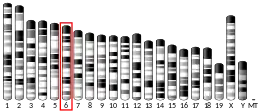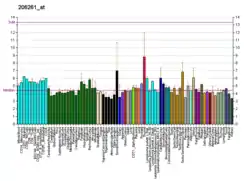ZNF239
Zinc finger protein 239 is a protein that in humans is encoded by the ZNF239 gene.[5][6][7]
Function
MOK2 proteins are DNA- and RNA-binding proteins that are mainly associated with nuclear RNP components, including the nucleoli and extranucleolar structures.[7][8]
References
- GRCh38: Ensembl release 89: ENSG00000196793 - Ensembl, May 2017
- GRCm38: Ensembl release 89: ENSMUSG00000042097 - Ensembl, May 2017
- "Human PubMed Reference:". National Center for Biotechnology Information, U.S. National Library of Medicine.
- "Mouse PubMed Reference:". National Center for Biotechnology Information, U.S. National Library of Medicine.
- Arranz V, Kress M, Ernoult-Lange M (Jan 1996). "Localization of zinc finger Mok2 gene to mouse chromosome 6, a new region of homology with human chromosome 19". Mammalian Genome. 7 (1): 77–8. doi:10.1007/s003359900020. PMID 8903737. S2CID 36851320.
- Ernoult-Lange M, Arranz V, Le Coniat M, Berger R, Kress M (Dec 1995). "Human and mouse Krüppel-like (MOK2) orthologue genes encode two different zinc finger proteins". Journal of Molecular Evolution. 41 (6): 784–94. doi:10.1007/bf00173158. PMID 8587123. S2CID 22955858.
- "Entrez Gene: ZNF239 zinc finger protein 239".
- Arranz V, Harper F, Florentin Y, Puvion E, Kress M, Ernoult-Lange M (Apr 1997). "Human and mouse MOK2 proteins are associated with nuclear ribonucleoprotein components and bind specifically to RNA and DNA through their zinc finger domains". Molecular and Cellular Biology. 17 (4): 2116–26. doi:10.1128/mcb.17.4.2116. PMC 232059. PMID 9121460.
- Dreuillet C, Tillit J, Kress M, Ernoult-Lange M (Nov 2002). "In vivo and in vitro interaction between human transcription factor MOK2 and nuclear lamin A/C". Nucleic Acids Research. 30 (21): 4634–42. doi:10.1093/nar/gkf587. PMC 135794. PMID 12409453.
Further reading
- Dreuillet C, Tillit J, Kress M, Ernoult-Lange M (Nov 2002). "In vivo and in vitro interaction between human transcription factor MOK2 and nuclear lamin A/C". Nucleic Acids Research. 30 (21): 4634–42. doi:10.1093/nar/gkf587. PMC 135794. PMID 12409453.
\* Kimura K, Wakamatsu A, Suzuki Y, Ota T, Nishikawa T, Yamashita R, Yamamoto J, Sekine M, Tsuritani K, Wakaguri H, Ishii S, Sugiyama T, Saito K, Isono Y, Irie R, Kushida N, Yoneyama T, Otsuka R, Kanda K, Yokoi T, Kondo H, Wagatsuma M, Murakawa K, Ishida S, Ishibashi T, Takahashi-Fujii A, Tanase T, Nagai K, Kikuchi H, Nakai K, Isogai T, Sugano S (Jan 2006). "Diversification of transcriptional modulation: large-scale identification and characterization of putative alternative promoters of human genes". Genome Research. 16 (1): 55–65. doi:10.1101/gr.4039406. PMC 1356129. PMID 16344560.
- Olsen JV, Blagoev B, Gnad F, Macek B, Kumar C, Mortensen P, Mann M (Nov 2006). "Global, in vivo, and site-specific phosphorylation dynamics in signaling networks". Cell. 127 (3): 635–48. doi:10.1016/j.cell.2006.09.026. PMID 17081983. S2CID 7827573.
External links
- ZNF239+protein,+human at the US National Library of Medicine Medical Subject Headings (MeSH)
This article incorporates text from the United States National Library of Medicine, which is in the public domain.




